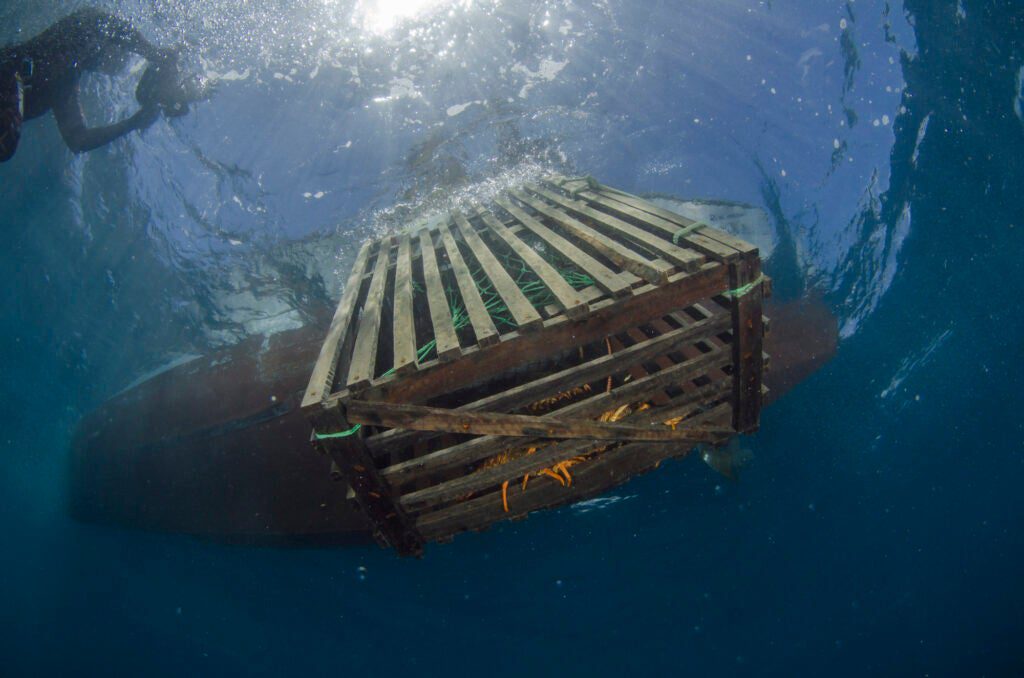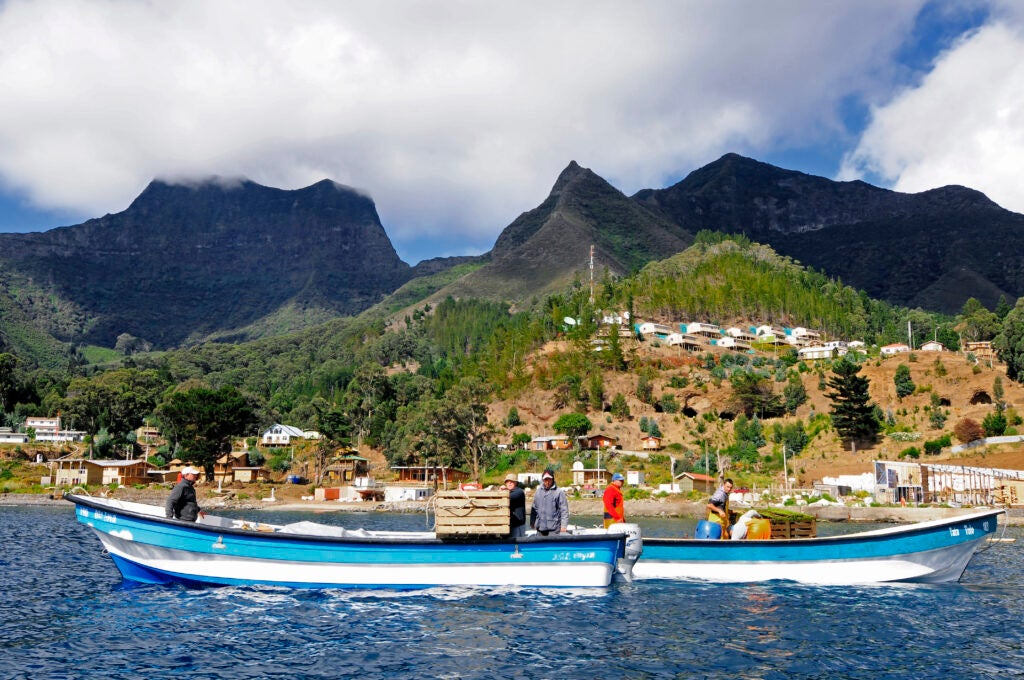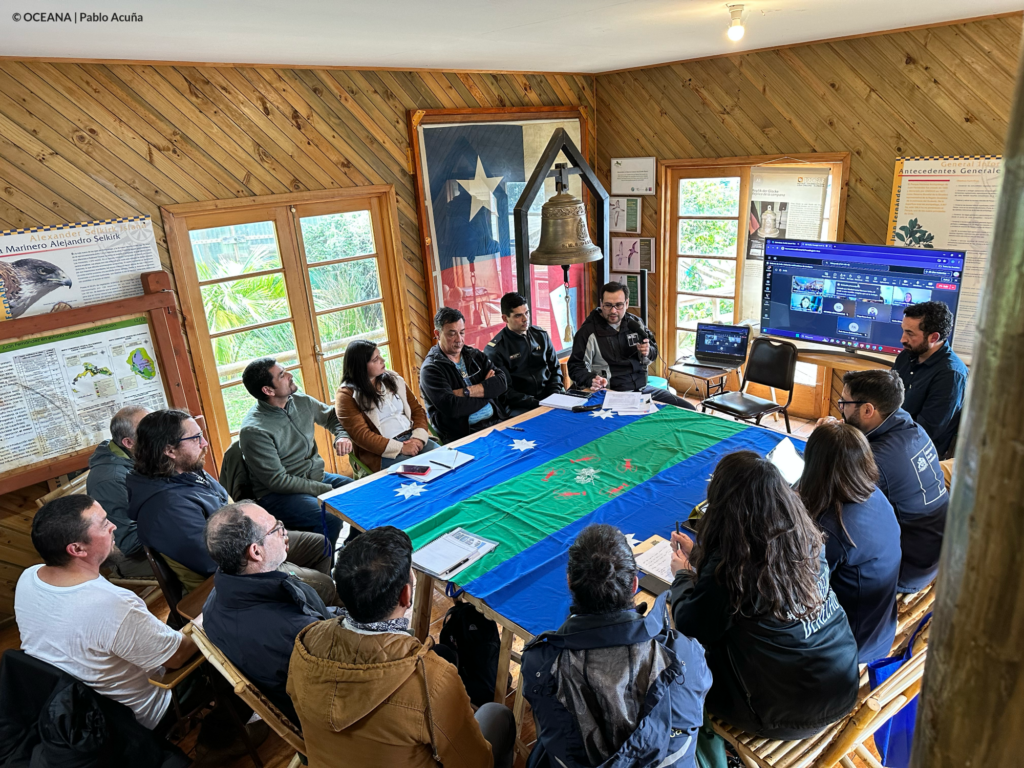May 14, 2025
The People’s Plan
BY: Sarah Holcomb
How fishers in Juan Fernández are protecting lobsters and livelihoods
A series of volcanic islands rise in the Pacific like a handful of skipped rocks off Chile’s coast. Once a pitstop for pirates and the rumored home of buried treasure, today the remote Juan Fernández Archipelago hosts 1,000 residents — and at least 15 times as many rock lobsters.
Islanders have fished the spiny, orange Juan Fernández rock lobster for generations. Decades before “sustainability” reached buzzword status, the fishers put limits in place to protect the prized lobsters from overfishing. Elsewhere, growing fishing fleets have depleted fish populations. Meanwhile, fishing in Juan Fernández has barely changed. Some believe there are just as many lobsters living among the archipelago’s rocky seamounts as ever before.
Today, the Juan Fernández rock lobster singlehandedly supports most of the islands’ economy. And as industrial fishing spreads globally, even to remote waters, local fishers know their livelihoods could soon be at risk. It’s time to protect their local waters before it’s too late.
Past, present, future

Fisher Daniel Gonzalez and a crew hoist a huge, handmade wooden box from the waters. It’s a trap, brimming with dozens of crawling lobsters. Each of the archipelago’s approximately 150 fishing families has their own fishing ground, called a marca. These dedicated sites dot the nearshore waters surrounding the archipelago’s three islands — Robinson Crusoe, Santa Clara, and Alejandro Selkirk — and the chain of underwater seamounts that make up the archipelago. Marcas are secret, never shared with outsiders.
As an added layer of security, fishing rights cannot be bought or sold. The only way to obtain lobster fishing rights is to inherit them. For islanders like Gonzalez, who grew up running along the islands’ docks and swimming its coves, becoming a fisher felt like “destiny.” Today, Gonzalez enjoys the freedom and independence of running his own fishing business. In fact, just about every aspect of the islands’ economy is owned by local families. But that was not always the case.
A century ago, companies in mainland Chile held a tight grip on the lobster industry and life on the islands. These companies controlled what supplies went in and out. They owned everything from the local general store to the fishing boats. Tired of their labor being exploited, fishers in Juan Fernández began building their own boats under the cover of night. They gradually gained their independence in the 1960s and 70s, and the Juan Fernández Fisherman’s Cooperative was born. Today, the islands’ economy is entirely in the people’s hands. Fishers export the vast majority of their lobster to China, where one tail can fetch $20.

The Fernandezian community has pioneered many ways of protecting the lobster population. Starting 90 years ago, the islanders stopped catching egg-carrying female lobsters to ensure the population stayed healthy. Gonzalez explains that fishers only catch lobster above a minimum size, by which point the lobster should be grown enough to have already reproduced at least five times, producing around 3 million eggs. They also close the fishing season from May 15 to Sept. 30 each year.
“We are always aware that where we are doing the fishing taxes the ecosystem,” says Gonzalez. After relying on lobster for the last 100 years, the community is counting on the next 100 years, too.
While the Juan Fernández rock lobster fishery has remained strong due to these limits, the archipelago witnessed a different fishery crash in the 1990s. Bottom trawlers intensively fished the orange roughy, a slow-growing, deep-sea fish species, driving it to nearly disappear.
To keep the rock lobster from meeting the roughy’s fate, the people of Juan Fernández sought to legally protect their surrounding waters. Small protected no-take areas already existed in waters around Robinson Crusoe island. Now, the islanders wanted to establish larger protected areas for local fishing grounds close to shore. The Fernandezian community partnered with Oceana to campaign for a new protected area that would allow both fishers and lobsters to thrive.
The campaign was successful. In 2016, Chile’s government announced the “Mar de Juan Fernández” Multiple-Use Marine Coastal Protected Area, which expanded in 2018 to cover 24,000 square kilometers (over 9,200 square miles) of protected ocean, plus a large-scale marine park. Admittedly a mouthful, the name’s technicalities hint at what makes this protected area special. It is multi-purpose, allowing both sustainable fishing and the continued safeguarding of the marine life living in this biodiverse habitat. In Juan Fernández, it’s clear that the two go hand-in-hand.

Tea for your thoughts
There was one problem with the new protected area. Without an official management plan on the books, it would merely become a “paper park” — protected in theory, but lacking the teeth needed to protect it in practice. Thus began an extensive collaboration between the local community, the Chilean government, scientists, and Oceana to establish a governance model.
In 2021, Dr. Liesbeth van der Meer, Oceana’s leader in Chile, called someone she thought could help: Dr. Ignacio Petit. A marine researcher, Petit had worked in Juan Fernández while completing his undergraduate thesis. After learning about the management plan, Petit eagerly joined the effort with Oceana.
The management plan proved to be a complex group project. A research organization called the Center for Ecology and Sustainable Management of Oceanic Islands (ESMOI) drafted the preliminary version of the plan, in collaboration with the Juan Fernández community and Chile’s government. Then Petit, along with his Oceana colleagues, spent months working with individual community members to incorporate their ideas. “What kinds of fishing should be allowed?” he’d ask, “and where?”
Much of the existing management would remain the same, continuing the fishers’ traditional sustainable practices. But the community decided they wanted some parts of the nearshore waters to require higher standards, with only certain fishing gear permitted.
With a 200-page draft in hand, the final phase began: ensuring everyone was on board. Over the next six months, a local team of women, led and coordinated by local resident Scheila Recabarren, visited people the way neighbors often do in Juan Fernández: over a cup of tea.
Neighbors hosted tea times with surrounding households — a chance to catch up with one another and to discuss the new plan. Oceana’s team attended many of these teas to chat with a dozen community members at a time. When they weren’t enjoying refreshments, the team knocked on nearly every door on the islands — ultimately reaching 89% of the archipelago’s residents. They also held workshops, meetings, and activities like trivia, recalls Recabarren.
It’s always difficult to reach consensus with hundreds of people, Petit points out. There were a few naysayers, but the process otherwise went smoothly. “People really wanted these protections,” Petit says. The new management plan boasts the highest community involvement of any in Chile’s history.
“It’s been scientifically proven that when communities are part of management plans, protected areas are better managed,” van der Meer emphasizes.
“It’s been scientifically proven that when communities are part of management plans, protected areas are better managed.”
-Dr. Liesbeth Van der Meer, Senior Vice President at Oceana
Still, a new challenge threatened to snag progress. The Juan Fernández community needed to elect representatives to oversee the plan as part of a Local Management Council. Unlucky timing meant this election fell too close to a political election and therefore was prohibited by Chilean law. They improvised a solution: “We worked with a legal consultant to create a community organization. Anyone could join the organization and help choose a board of leaders,” Sofía Ramirez, Oceana’s Director of Operations in Chile, explains.
The members approved a diverse group of representatives from the community, as well as tourism and fishing stakeholders from each of the three islands — including Daniel Gonzalez. Part of the Local Governance Council, these individuals voice concerns on behalf of the people and work directly with government officials to ensure everyone is represented.
In September 2024, they met around a table to officially sign off on the long-awaited plan.

Signed and sealed
The Juan Fernández Archipelago is home to dozens of species found nowhere else in the world. Diving in these abundant waters is like “seeing the ocean as it used to be,” says Ramirez. “You’re so surrounded by fish, you have to fan them out of the way.” Hundreds of fur seals, dolphins, and whales swim through these waters. It’s hard to imagine a more fitting location to be honored with the first fishery management plan approved under Chile’s newly minted law, the Biodiversity and Protected Areas Service (SBAP in Spanish).
The day the plan received its final signatures was a blur. One day last September, Ramirez, who had been working to coordinate the sign-off for months, heard on short notice that the Minister of Environment — along with the other needed representatives from public agencies — could fly in the next day. She rushed to pull an event together. Less than 24 hours later, local and national leaders were smiling for photos with the signed plan, backgrounded by the island’s jagged cliffs and glossy Pacific waters.
Due to its long history in Juan Fernández, Oceana has built trust among community members, says Ramirez. “We work behind the scenes, collaborating with and accompanying the community. They are deeply dedicated to protecting the future of these waters and their rich fishing tradition.”
“I hope that traditional practices will continue to be carried out in a sustainable manner and new activities will be carried out with respect for our environment,” emphasizes Recabarren. “My greatest wish is that we achieve a balance between the protection of our marine ecosystems and the well-being of our community, always thinking of future generations.”



